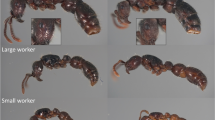Abstract
Social parasites exploit the worker force of colonies of other social insects to rear their own young. Social parasitism occurs in several Hymenoptera and is particularly common in several tribes of the ant subfamilies Myrmicinae and Formicinae. Here, we document the occurrence of miniaturized queens (microgynes) in colonies of Ectatomma tuberculatum, an ant belonging to the subfamily Ectatomminae. Behavioral observations and genetic analyses show that microgynes concentrate their reproductive efforts almost exclusively on the production of sexual offspring (microgynes and males), whereas the regular, large queens (macrogynes) produce workers in addition to sexuals. According to mitochondrial and nuclear markers, gene flow between microgynes and macrogynes is extremely limited. Whereas the co-occurrence of microgynes and macrogynes in the related species Ectatomma ruidum constitutes an intraspecific polymorphism associated with alternative dispersal tactics, microgynes found in colonies of E. tuberculatum appear to be a distinct species and to represent the first case of social parasitism in the poneromorph subfamilies of ants.


Similar content being viewed by others
References
Altmann J (1974) Observational study of behavior: sampling methods. Behaviour 49:221–267
Aron S, Passera L, Keller L (1999) Evolution of social parasitism in ants: size of sexuals, sex ratio and mechanisms of caste determination. Proc R Soc Lond B 266:173–177
Bolton B (1988) A new socially parasitic Myrmica, with a reassessment of the genus (Hymenoptera: Formicidae). Syst Entomol 13:1–11
Bolton B (2003) Synopsis and Classification of Formicidae. Memoirs of the American Entomological Institute, Gainesville
Bourke AFG, Franks NR (1991) Alternative adaptations, sympatric speciation and the evolution of parasitic, inquiline ants. Biol J Linn Soc 43:157–178
Buschinger A (1982) Leptothorax faberi n. sp., an apparently parasitic ant from Jasper National Park Canada (Hymenoptera: Formicidae). Psyche 89:197–209
Buschinger A (1986) Evolution of social parasitism in ants. Trends Ecol Evol 1:155–160
Buschinger A (1990) Sympatric speciation and radiative evolution of socially parasitic ants - Heretic hypotheses and their factual background. Z Zool Syst Evolutionsforsch 28:241–260
Crozier RH, Crozier YC (1993) The mitochondrial genome of the honeybee Apis mellifera: complete sequence and genome organisation. Genetics 133: 97–117
Crozier RH, Kaufmann B, Carew ME, Crozier YC (1999) Mutability of microsatellites developed for the ant Camponotus consobrinus. Mol Ecol 8:271–276
Delabie JHC (1990) The ant problems of cocoa farms in Brazil. In: Meer RKV, Jaffe K, Cadeno A, (eds) Applied Myrmecology—a world perspective. Westview, Boulder, CO, pp 555–569
D'Ettorre P, Mondy N, Lenoir A, Errard C (2002) Blending in with the crowd: social parasites integrate into their host colonies using a flexible chemical signature. Proc R Soc Lond B 269:1911–1918
Elmes GW (1976) Some observations on the microgyna form of Myrmica rubra L. (Hymenoptera, Formicidae). Insectes Soc 23:3–21
Elmes GW (1978) A morphometric comparison of three closely related species of Myrmica (Formicidae), including a new species from England. Syst Entomol 3:131–145
Elmes GW (1991) Mating strategy and isolation between the two forms, macrogyna and microgyna of Myrmica ruginodis (Hym. Formicidae). Ecol Entomol 16:411–423
Fénéron R (1993) Ethogenèse et reconnaissance interindividuelle—influence de l'expérience précoce chez une fourmi ponérine (Ectatomma tuberculatum Olivier). Ph.D dissertation, Université Paris XIII, Villetaneuse France
Fénéron R, Billen J (1996) Ovarian cycle in Ectatomma tuberculatum workers (Formicidae, Ponerinae). J Invert Reprod Develop 29:79–85
Fénéron R, Durand JL, Jaisson P (1996) Relation between behavior and physiological maturation in a ponerine ant. Behaviour 133:791–806
Fénéron R, Nowbahari E, Dutrou F (1999) Reconnaissance intercoloniale et niveau d'agression chez la fourmi ponérine, Ectatomma tuberculum. Actes Coll Insect Soc 12:33–36
Fresneau D, Charpin A (1977) Une solution photographique au problème du marquage individuel des petits insectes. Ann Soc Entomol France 13:423–426
Garcia-Perez JA, Peña-Sanchez R, Camargo-Huiqui P, Champalbert A (1991) Rutas de forrajeo utilizadas por Ectatomma tuberculatum O. (Hymenoptera, Ponerinae) en una plantacion de cacao en el Soconusco, Chiapas, Mexico. Folia Entomol Mex 82:161–171
Heinze J (1995) The origin of workerless social parasites in formicoxenine ants. Psyche 102:195–214
Hölldobler B, Wilson EO (1990) The ants. Harvard University Press, Cambridge, MA
Hora RR, Fénéron R, Valenzuela J, Favila ME, Fresneau D (2001) Queen-size dimorphism in the ant Ectatomma tuberculatum (Hymenoptera: Formicidae: Ponerinae). Sociobiology 38:407–420
Hora RR (2003) Strategies de reproduction et parasitisme social chez la fourmi ponerine Ectatomma tuberculatum (Olivier). Ph.D. thesis, Université Paris 13, Villetaneuse France
Hora RR, Vilela E, Fénéron R, Pezon A, Fresneau D, Delabie J (2005) Facultative polygyny in Ectatomma tuberculatum (Formicidae: Ectatomminae). Insectes Soc 52:194–200
Jukes TH, Cantor CR (1969) Evolution of protein molecules. In: Munro HN (ed) Mammalian protein metabolism. Academic Press, New York, pp 21–132
Keller L, Passera L (1989) Size and fat content of gynes in relation to the mode of colony founding in ants (Hymenoptera: Formicidae). Oecologia 80:236–240
Lachaud JP, Cadena A, Pérez-Lachaud G, Schatz B (1999a) Polygynie et stratégies reproductrices chez une ponérine néotropicale, Ectatomma ruidum. Actes Coll Insec Soc 12:53–59
Lachaud JP, Cadena A, Schatz B, Pérez-Lachaud G, Ibarra-Núñez G (1999b) Queen dimorphism and reproductive capacity in the ponerine ant, Ectatomma ruidum Roger. Oecologia 120:515–523
Lebart L, Fénelon JP (1971) Statistique et informatique appliquées, Paris Dunod
Leberg PL (2002) Estimating allelic richness: effects of sample size and bottlenecks. Mol Ecol 11:2445–2449
Maschwitz U, Dorow WHO, Buschinger A, Kalytta G (2000) Social parasitism involving ants of different subfamilies: Polyrhachis lama (Formicinae) an obligatory inquiline of Diacamma sp. (Ponerinae) in Java. Insectes Soc 47:27–35
Maschwitz U, Go C, Dorow WHO, Buschinger A, Kohout RJ (2003) Polyrhachis loweryi (Formicidae): A guest ant parasiting Rhytidoponera sp. (Ponerinae) in Queensland, Australia. Insectes Soc 50:69–76
Nonacs P, Tobin JE (1992) Selfish larvae: development and the evolution of parasitic behavior in the Hymenoptera. Evolution 46:1605–1620
Passera L (1980) La fonction inhibitrice des reines de la fourmi Plagiolepis pygmaea L.: rôle des pheromones. Insectes Soc 27:212–225
Pearson B, Child A (1980) The distribution of an esterase polymorphism in macrogynes and microgynes of Myrmica rubra Latreille. Evolution 34:105–109
Pearson B (1981) The electrophoretic determination of Myrmica rubra as a social parasite: possible significance in the evolution of ant social parasites. In: Howse PE, Clément JL (ed) Systematics association special volume no 19, biosystematic of social insect. Academic Press New York, pp 75–84
Peeters CP (1991) Ergatoid queens and intercastes in ants: two distinct adult forms which look morphologically intermediate between workers and winged queens. Insectes Soc 38:1–15
Peeters C, Crewe R (1984) Insemination controls the reproductive division of labour in a ponerine ant. Naturwissenschaften 71:50–51
Poteaux C, Hora RR, Vautrin D, Fresneau D, Solignac M (2003) Isolation of polymorphic microsatellite loci in the ponerine ant Ectatomma tuberculatum. Mol Ecol Notes 3:635–637
Raymond M, Rousset F (1995) Genepop (version 1.2) population genetics software for exact tests and ecumenicism. J Hered 86:248–249
Rüppell O, Heinze J (1999) Alternative reproductive tactics in females: the case of size polymorphism in winged ant queens. Insectes Soc 46:6–17
Savolainen R, Vepsäläinen K (2003) Sympatric speciation through intraspecific social parasitism. Proc Natl Acad Sci USA 100:7169–7174
Schatz B, Lachaud JP, Peeters C, Pérez-Lachaud G, Beugnon G (1996) Existence de microgynes chez la fourmi ponérine Ectatomma ruidum Roger. Actes Coll Insect Soc 10:169–173
Seppä P (1992) Genetic relatedness of worker nestmates in Myrmica ruginodis (Hymenoptera: Formicidae) populations. Behav Ecol Sociobiol 30:253–260
Stille M (1996) Queen/worker thorax volume ratios and nest-founding strategies in ants. Oecologia 105:87–93
Sumner S, Nash DR, Boomsma JJ (2003) The adaptive significance of inquiline parasite workers. Proc R Soc Lond B 270:1315–1322
Sumner S, Aanen DK, Delabie JHC, Boomsma JJ (2004) The evolution of social parasitism in Acromyrmex leaf-cutting ants: a test of Emery's rule. Insectes Soc 51:37–42
Ward PS (1989) Genetic and social changes associated with ant speciation. In: Breed MD, Page RE (ed) The genetics of social evolution. Westview, Boulder, CO, pp 123–148
Wilson EO, Brown WL Jr (1956) New parasitic ants of the genus Kyidris, with notes on ecology and behavior. Insectes Soc 3:439–454
Wilson EO (1971) The insect societies. Harvard Univ Press, Cambridge, MA
Acknowledgements
We are particularly grateful to R. Blatrix and anonymous referees for their invaluable comments on the manuscript. We also thank C. Alaux, E. Baudry, D. Denis, and A. Pezon for their helpful comments and English revision. We acknowledge M. Favila (INECOL, Mexico) for providing facilities during our fieldwork, and Emilio, Gregorio, C. Rojas, A. Wolf, and K. Wolf for the technical supports in the field as well as M. Richard and B. Viginier for support during the molecular biology work. The project was partly financed by BRI (Université Paris-Nord) and ACI 2001 (No 5183). R. R. Hora received financial support from CAPES, Brazil, Project CAPES/COFECUB No 244/98-II. This work was conducted under Mexico and France legal requirements.
Author information
Authors and Affiliations
Corresponding author
Additional information
Communicated by L. Keller
Rights and permissions
About this article
Cite this article
Hora, R.R., Doums, C., Poteaux, C. et al. Small queens in the ant Ectatomma tuberculatum: a new case of social parasitism. Behav Ecol Sociobiol 59, 285–292 (2005). https://doi.org/10.1007/s00265-005-0040-9
Received:
Revised:
Accepted:
Published:
Issue Date:
DOI: https://doi.org/10.1007/s00265-005-0040-9




